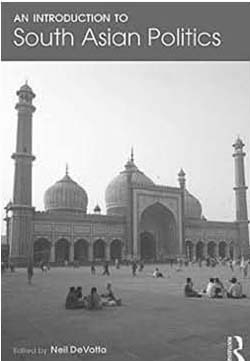Given the legacy of colonialism and the lack of transition that the South Asian states have made to frameworks for understanding alternative cartographic imaginations, nation-states, modernity, development and security issues both at the national and regional level, Niel De Votta’s edited work, An Introduction to South Asian Politics, is an important contribution towards laying out the broad contours and contemporary canvas of South Asian politics. It has been argued that fragile domestic structures in South Asia have largely been responsible for determining the national, regional and international politics of South Asia, and the idea of South Asia in the 21st century and beyond will continue to be governed by this important variable. Perhaps based on this broad assumption, the authors who have contributed to this significant collection, examine six South Asian countries—Afghanistan, Bangladesh, India, Nepal, Pakistan and Sri Lanka. The broad question as the editor himself identifies at the outset is to employ ‘a democratic prism to analyse the region’s domestic politics’ (p. 1). To what extent have the respective South Asian countries been able to consolidate both democracy and governance? Have the South Asian countries been able to match the parameters of democratic participation, in terms of institutions, parties and elections? The politics of South Asia has been introduced with this question directing the course of inquiry.
The rationale for revisiting South Asian politics, as De Votta argues is to situate South Asian countries ‘within the broader discourses of global power shifts from Western states to countries in Asia in an increasingly multi-polar world’ (p. 1). While this question posed at the outset is an interesting entry point to gauge the trajectory of South Asian politics as it has emerged in the past and as it would possibly shape up in the near future, the lack of engagement with this question in the concluding and introductory chapters emerges as the key weakness of the book.
There are indeed common themes which have inflicted all South Asian states, given the diversity of and in particular, their individual and distinct trajectories. Good governance, legitimacy of the state, corruption, demographic dividend, fast growing economies are some features which have been identified by the authors. For instance, Jason Kirk, commenting on the democratic evolution of India, states that, ‘as India’s population nears 1.25 billion, there are more than 600 million under age 25, and 70 percent of the population is under 40.’ Citing a few sources, he notes that ‘there is a startling four decade gap between the median age of India’s people and that of its government officials… Among the world’s major countries, India has the youngest population, and the oldest leaders’ (p. 5): This is important because this ‘young versus the old tension’ is bound to manifest in most of the South Asian countries in the years to come. An interesting thematic distinction made by Kirk is the nuanced differentiation between formal and informal institutions (p. 10–19), whereby the concept of informal institutions could have been taken as one of the primary themes of discussion for the other chapters/ countries too.
Customs, culture and traditions have played an important role in shaping the relationship between societies, communities and the state in South Asia. These are durable social practices, which have organically evolved over a period of time, rather than being designed to play a major role in shaping the inter-subjective understanding between the individual and the communities.1 This is an important variable in understanding the politics-society encounter/interaction in South Asia. For instance, Ali Riaz commenting on the nature of politics in Bangladesh writes that institutions, political parties and elections are tied together with the culture of politics of the country more appropriately identified as patrimonialism (p. 71). Similar patterns are echoed in countries like Afghanistan, Nepal, Pakistan and Sri Lanka all of which have shades and legacies of such patrimonial tendencies and have been documented by all authors.

